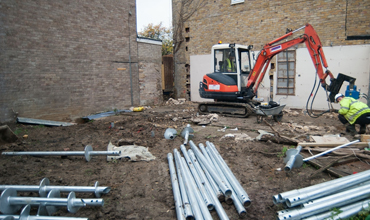Information
Screw pile solutions are used when circumstances do not allow a traditional underpinning process to be implemented. Some building projects may require excavation to great depths, or sites do not allow the use of piling rig machinery, in these situations screw piles are ideal solutions.
Piles can be installed small crews by hand (if feasible) or by using small equipment such as a mini excavator. They have capacity to work in compression, tension, withstand vertical / lateral forces (e.g wind), vibration and shear forces.
One of the most important features of screw piles and helical anchors is the verification of load capacity during installation.
A torque measuring device that measures the installation torque as the pile/anchor advances into the ground is used to record the capacity as the pile advances. Studies have shown that the installation torque and load capacity are proportional. This means that loads can be verified immediately and checked against a static design derived from subsoil data. Whether designing for new builds, underpinning or ground stabilisation Screw Piles Ltd foundation systems provide minimal mess, noise and disruption.
Screw piles have a great many benefits over traditional piling solutions, speed of installation, low noise and minimal vibration or disruption which can cause damage to the surrounding site area.
Examples of where screw/underpinning solutions are used:
- Foundations undergoing settlement.
- Support on unconsolidated made ground.
- Ground erosion.
- Ground affected by subsidence or heave.
- When foundations have moved as a result of landslip or unstable slopes.
- Foundations affected by mine workings.
- Vibration damage.
- Increase in load or alterations to existing load path.
- New / adjoining building structure
A selection of our projects
- Suffolk 16th century moated hall. Kitchen extension. 16 screw piles with a reinforced concrete foundation to support a new timber frame extension.
- Temporary wooden viewing tower at Cley-next-the-Sea for the annual contemporary art exhibition. 4.0M deep screw piles were installed for this project to take compression and tension loadings.
- A grid of 12 screw piles for a Silo tank base at a food processing plant in Wellingborough.
- Electricity transformer substation Unit at Bromley bus station. Installed 5 screw piles to replace foundations situated on the slope of a railway embankment.
- Trial wind turbine base unit for 12M high turbines, installed at three trial sites in Norfolk and Hertfordshire.
Typical residential screw pile
applications and benefits include:
- Underpinning house foundations
- Underpinning a conservatory
- Screw piles for sheds and huts
- Foundations for extension
- Summer house foundations
- Garden offices foundations
- Garage foundations
- Foundation underpinning for decks and walkways
- Tree roots avoidance support systems
- Underpinning retaining walls and boundaries
- Underpinning costs less than other solutions
- Screw piles for fixed caravans
Typical commercial screw pile
applications and benefits include:
- Alternative to CFA and driven cased mini piles
- Temporary structures support
- Tree roots avoidance support systems
- Foundation solutions in contaminated ground
- Civil engineering, Water treatment & other utilities
- Underpinning in new build constructions
- Large scale signage foundations
- Highways and other road building projects
- Cost effective solutions for railway projects
- Power & energy, telecommunications
- Electrification network expansion
Site Access
Most sites can accommodate the equipment required to install screw piles. For limited access sites, and screw piles inside buildings, modular components can be used to install the piles. For most sites a range of specifically designed, high power, CE approved torque drill heads are mounted on mini diggers that range from 1.5T up to 5T.



